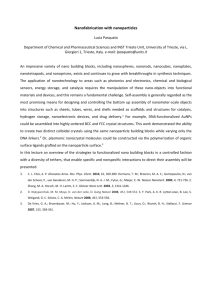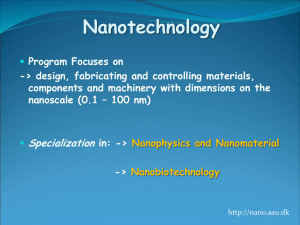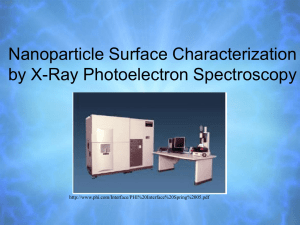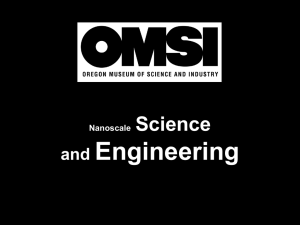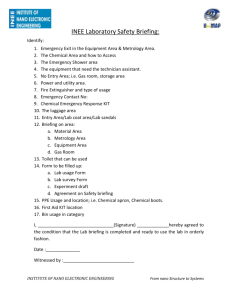AssessN-producsjigsa..
advertisement
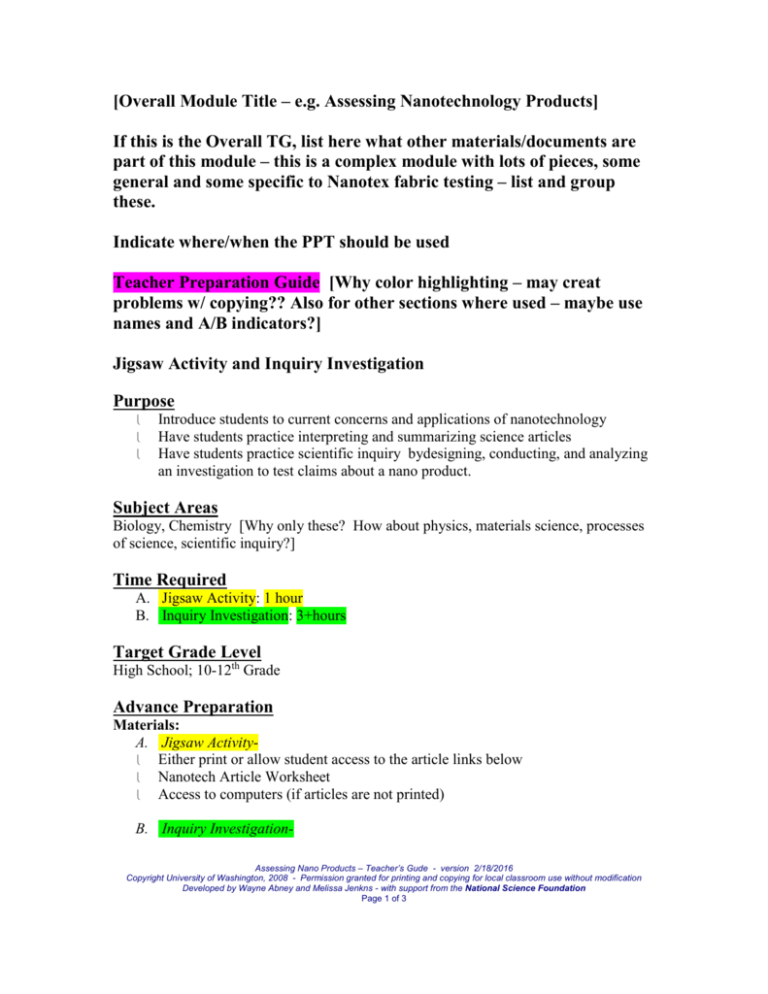
[Overall Module Title – e.g. Assessing Nanotechnology Products] If this is the Overall TG, list here what other materials/documents are part of this module – this is a complex module with lots of pieces, some general and some specific to Nanotex fabric testing – list and group these. Indicate where/when the PPT should be used Teacher Preparation Guide [Why color highlighting – may creat problems w/ copying?? Also for other sections where used – maybe use names and A/B indicators?] Jigsaw Activity and Inquiry Investigation Purpose Introduce students to current concerns and applications of nanotechnology Have students practice interpreting and summarizing science articles Have students practice scientific inquiry bydesigning, conducting, and analyzing an investigation to test claims about a nano product. Subject Areas Biology, Chemistry [Why only these? How about physics, materials science, processes of science, scientific inquiry?] Time Required A. Jigsaw Activity: 1 hour B. Inquiry Investigation: 3+hours Target Grade Level High School; 10-12th Grade Advance Preparation Materials: A. Jigsaw Activity Either print or allow student access to the article links below Nanotech Article Worksheet Access to computers (if articles are not printed) B. Inquiry InvestigationAssessing Nano Products – Teacher’s Gude - version 2/18/2016 Copyright University of Washington, 2008 - Permission granted for printing and copying for local classroom use without modification Developed by Wayne Abney and Melissa Jenkns - with support from the National Science Foundation Page 1 of 3 Various nano products, as well as their non-nano version. Some examples: silver nanoparticle or nanothread socks, silver nano particles [not typically products themselves], nanoparticle-based sunscreen and/or cosmetics, NanoTex fabric, silver nanoparticle band-aids, silver nanoparticle pacifiers, silver nanoparticle sealable bags. For more examples, follow this link: http://www.nanotechproject.org/inventories/consumer/. Because students will be designing their own investigations, a comprehensive list of materials will be unique to each class. “Nanotechnology Product Investigation Planning Page” (for students) “Lab Report Guidelines” page (for students) Lab Report Scoring Rubric [I don’t find this among the materials sent/left] Teaching Strategies A. Jigsaw DescriptionStudents pair off to read and summarize an article about nanotechnology. Assign one article to each group. Student share their findings with the class,describing their articles, so everyone ends up with an overview of all articles. Links to some great article are attached. Additional articles can be easily added to the list. After students have shared their articles, direct all students to the following webpage: http://www.nanotechproject.org/inventories/consumer/ This webpage contains a searchable list of nanotechnology based products available now. From the webpage: “Consumer Products: An inventory of nanotechnology-based consumer products currently on the market. After more than twenty years of basic and applied research, nanotechnologies are gaining in commercial use. Nanoscale materials now are in electronic, cosmetics, automotive and medical products. But it has been difficult to find out how many “nano” consumer products are on the market and which merchandise could be called “nano.” While not comprehensive, this inventory gives the public the best available look at the 500+ manufacturer-identified nanotechnology-based consumer products currently on the market.” Follow-Up Discussion Questions 1. Are nanoparticles safe? Why/Why not?/How do we know? 2. What are some NEW applications for nanotechnology? 3. Why use nanoparticles for these products? 4. Should nanoparticles be used in cosmetics if they have not been tested? 5. How could you test the effectiveness of some of the nano products on the market now? 6. How could you test the safety of some of the nano products on the market now? Assessing Nano Products – Teacher’s Gude - version 2/18/2016 Copyright University of Washington, 2008 - Permission granted for printing and copying for local classroom use without modification Developed by Wayne Abney and Melissa Jenkns - with support from the National Science Foundation Page 2 of 3 Teaching Strategies (continued) B. Inquiry Investigation1. After students have read and discussed current nanotechnology products (Link: http://www.nanotechproject.org/inventories/consumer/) in the jigsaw activity, have students brainstorm possible investigations. Students investigations can test the claims of a nanotechnology product on the market OR the safety of such products.* *For students testing safety, have them test the products on a Petri dish culture of yeast (eukaryotic cells) compared to the non-nano version. [This seems to me to need more introduction. Will teachers know what to do or what you mean? Is there a general protocol for testing with yeast that you can reference? ] Some Ideas: Is NanoTex fabric more stain resistant then Scotchguard treated cloth? Does nano sunscreen block more UV light then non-nano sunscreen? (UV color changing beads can be used, as well as a Petri plate of yeast colonies with sunscreen spread on the lid top and exposed to UV light) Does NanoTex fabric still resist stains as well after ________ washes? Do nano silver Ziploc bags keep food fresh longer then regular Ziploc bags? 2. Have students complete “Nanotechnology Product Investigation Planning Page” [Is this the Inquiry Investigation Planning Page? Need to be consistent in naming and references.] worksheet (attached). Review student questions, materials, and procedure before granting permission to proceed with the investigation. 3. Students should complete a formal lab report for their investigation, using the investigation checklist and rubric [need to have this available] to guide their report. Assessment Formal Lab Report, including question, hypothesis, procedure, data, results, and conclusion. Use the Investigation Rubric [need to have this available] to score student work. Assessing Nano Products – Teacher’s Gude - version 2/18/2016 Copyright University of Washington, 2008 - Permission granted for printing and copying for local classroom use without modification Developed by Wayne Abney and Melissa Jenkns - with support from the National Science Foundation Page 3 of 3


